The iPhone 6 Review
by Joshua Ho, Brandon Chester, Chris Heinonen & Ryan Smith on September 30, 2014 8:01 AM EST- Posted in
- Smartphones
- Apple
- Mobile
- iPhone 6
Camera
In order to really understand the camera of the iPhone 6, we have to first talk about the components that make up the camera system. While we don’t know the exact model number of either the iPhone 5s or iPhone 6 sensors, we do know that both the front and rear cameras are made by Sony. For the most part, it seems that the optical system is largely unchanged from the iPhone 5s to iPhone 6. The focal length and aperture are identical, and both have five plastic lenses. On the sensor side there are some obvious differences such as the addition of phase detection pixels. However, it’s otherwise difficult to say if anything else has changed in this area. There’s also a new ISP on the SoC, which serves to enable features like 240FPS slow motion video.
Based on what we know about the camera, the one highlight feature seems to be PDAF. While we’ve seen it before in phones like the Galaxy S5, we’ve never really talked about how it works. In short, microlenses on the sensor refract incoming light onto the AF detector in pairs, as seen in the photo below. Once this is done, the image produced by each AF sensor is compared for similarities. By finding these similarities, the ISP can know whether the lens is focused at a point short, long, or on the intended subject and command lens movement to focus on the intended subject. In case 1 in the photo, we see a situation where the camera is focused short, so the lens must move in order to properly focus on the subject, which is case 2. Case 3 and 4 show increasingly extreme cases of focusing too far to focus on the subject.
Source: Wikipedia
The real question is how it works. While we don't have an ideal test for auto focus and capture latency, we can at least get an idea for best case latency by looking at latency for both cases when viewing a well lit ISO chart, which has extremely high contrast and strong lighting so PDAF should be able to operate.

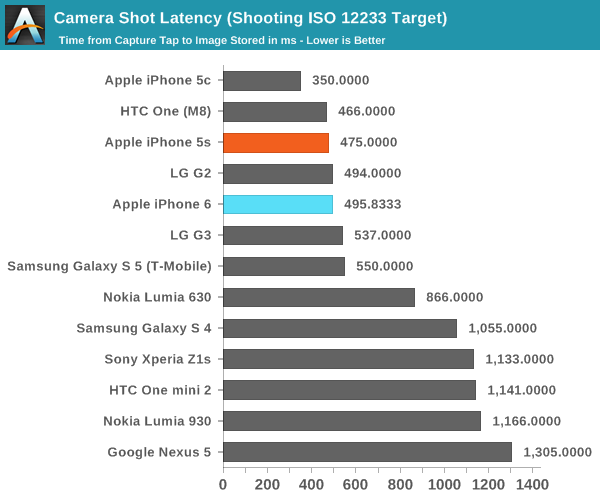
As you can see, it seems that capture latency is mostly unchanged when comparing the two phones but focus latency is dramatically improved in the best case, which is around 200 milliseconds. While the Galaxy S5 does have PDAF, in my experience it was hard to tell if it was any faster than a mostly contrast-based solution like the One M8. With the iPhone 6 the use of PDAF is immediately obvious because in well lit conditions the camera always snaps to focus without ever waiting for the ISP to detect an out of focus condition and run an AF scan. Oddly enough, in all of the manual camera applications that I've tried none of them seem to be able to use continuous auto focus in the preview, which suggests that this isn't exposed in the camera API.
On the UI side, the new camera application isn't a significant departure from what we're used to in iOS but there is one odd UI inconsistency present in the new UI, as in the slow motion video mode tapping the fps option will toggle between 120 and 240 fps but the same isn't true of 1080p60 video, which has to be toggled through the settings application instead of within the camera application.
Otherwise, I'm generally happy with the camera, especially with the new exposure biasing mode which does away with the need to try and get a specific exposure by locking exposure and reframing to get the right photo. While this certainly isn't a new feature the ease of use makes for a better implementation than most. Generally, exposure biasing is hidden in the settings menu so it's a setting that is only selected once and never again. However, Apple's solution will always default to 0 EV and allow for biasing by swiping up to increase exposure and down to reduce it, which means that this solution is fast and easy to do when taking a photo.
Overall, I don't have significant complaints with the camera UI or the general shooting experience. While I'm still looking for an ideal manual camera application I find Apple's mostly all auto solution to be more than sufficient. Of course, the shooting experience alone isn't enough to evaluate a camera so we'll look at image quality next.
Still Image Performance
While I'm still not quite happy with the state of our camera testing procedures, our current tests can generally give a good relative comparison, so the data we're looking at can still be used to draw some conclusions about the camera being tested. One of the first tests that we'll look at is the ISO chart, which uses increasingly tight line spacing to determine what the maximum resolution of the camera is.
In this test, the iPhone 6 does reasonably well, showing low aliasing until around the 16 or 17 mark, which seems to be about the same as the iPhone 5s. In general, this is one area where the iPhone falls short of the competition, which generally tends towards 1.1 micron pixels and sensor sizes larger than a third of an inch. However, it's definitely a great more detail than what we see on the four megapixel sensor of the One (M7) or One (M8). Given the sensor size constraints that Apple seems to be working with this is a respectable showing.
The next scene we'll look at is a daytime landscape shot. For the most part the iPhone 6 does admirably, as noise is well suppressed without noticeable oil painting effects that arise from when noise suppression is too strong and blurs out detail. Dynamic range is also generally quite good as shadowed areas have noticeable detail in this scene. In comparison to the iPhone 5s, while it's relatively hard to see any real differences in detail the noise in areas like the sky and in shadows are noticeably reduced without an obvious decrease in detail.
Following along the lines of the landscape shot, I also set up a lightbox scene with a few objects of varying contrasting textures, text, and feature size to get a good idea of what the limitations of the camera are. In this test scene, we actually see some level of improvement in detail when comparing the iPhone 5s to the iPhone 6. This is most obvious when looking closely at the texture of the metal bell. When compared to the Galaxy S5 LTE-A the iPhone 6 does fall behind a bit due to lower resolution and a mildly wider field of view.
For the next scene, I used the light box and standardized dim lighting in order to provide an example of camera performance between extremely bright and dark scenes. Here, it's relatively difficult to see a difference between the various phones, although with some cameras we're already starting to see a significant amount of detail blurred away in areas like the bell which has a great deal of low contrast detail. There's not too much difference here when comparing the iPhone 6 and 5s, although the 6 does have noticeably lower contrast in these situations.
At the extremes of low light photos, we definitely see a notable improvement in the iPhone 6, which can be attributed to the lower ISO. However, for better or worse we don't see a significant difference in exposure which suggests that this sensor likely has improved sensitivity despite identical pixel size. While we have no way of knowing the exact sensor, it's logical to conclude that the iPhone 6 is using a CMOS sensor process similar to the IMX240 in the GS5 LTE-A at a larger pixel pitch for better sensitivity. What's really incredible about this test photo is that the iPhone 6 manages to deliver an output close to what we see in the iPhone 6 Plus at four times the ISO/sensor gain.
The next two test cases are less about the camera itself and more about how well the OEM has integrated software and hardware. The first test we'll go over is the LED flash test in the lightbox scene that was previously used. While LED flash is generally a rather poor solution for low light photos, it's still important to test as there are some situations where it's absolutely necessary. In this case, Apple has done a great job of selecting an appropriate brightness level to evenly illuminate the scene and provided enough light to keep noise to a minimum, but for some reason there's a pink/red tint to the entire scene. This is one area where the iPhone 5s seems to provide more even color rendering as there is no such tint.
In the HDR test, there's a noticeable improvement in detail and dynamic range from the iPhone 5s to the iPhone 6. Key areas of note include the Media Link HD box, which has noticeably clearer text and there's also significantly more detail on the bell. Judging by the general improvements to detail in closer shots, it may be that these effects are either too subtle to see in landscapes or simply smudged away by noise reduction. There's relatively little to criticize here, as Apple seems to be effectively merging multiple exposures without obvious halos or similar effects that make HDR almost impossible to use in most circumstances.
Overall, the iPhone 6's camera represents a solid improvement over the previous generation, with less noise, more detail in some circumstances, better HDR, and improved low light performance. While it isn't a huge leap ahead, it's definitely more than one might expect. The improvements are subtle though, as there are no fundamental changes to the optics or sensor.








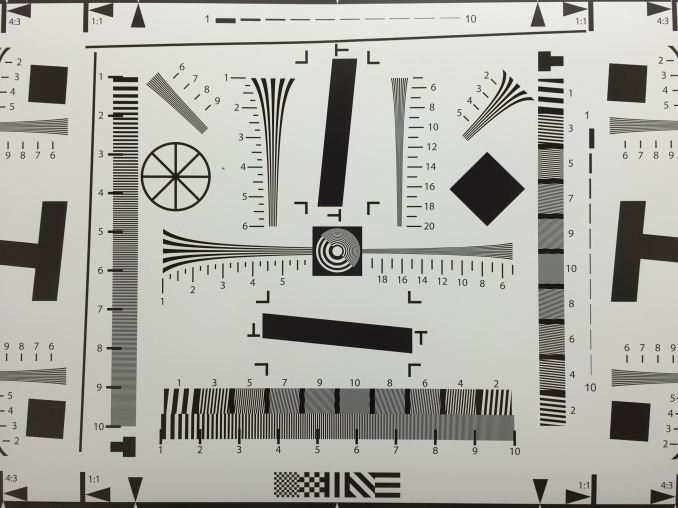






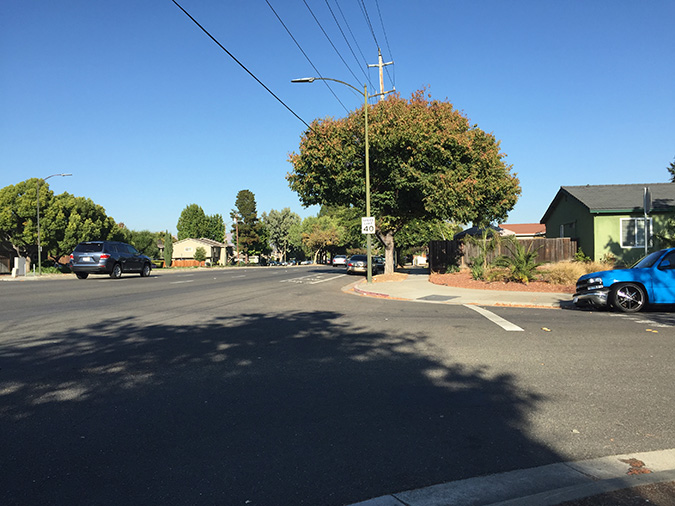






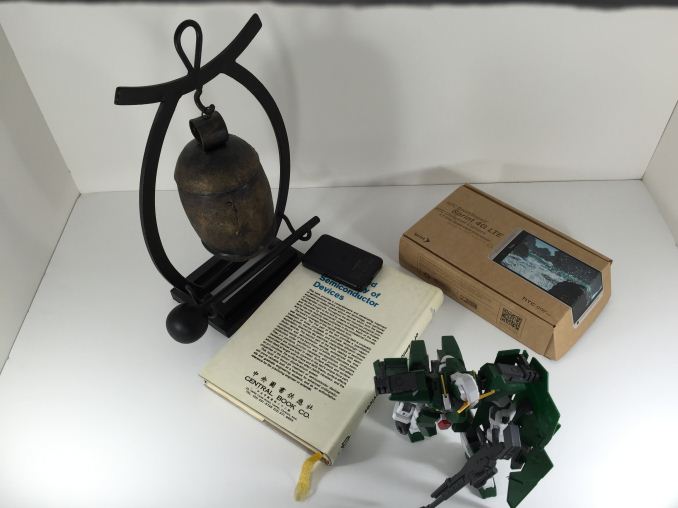






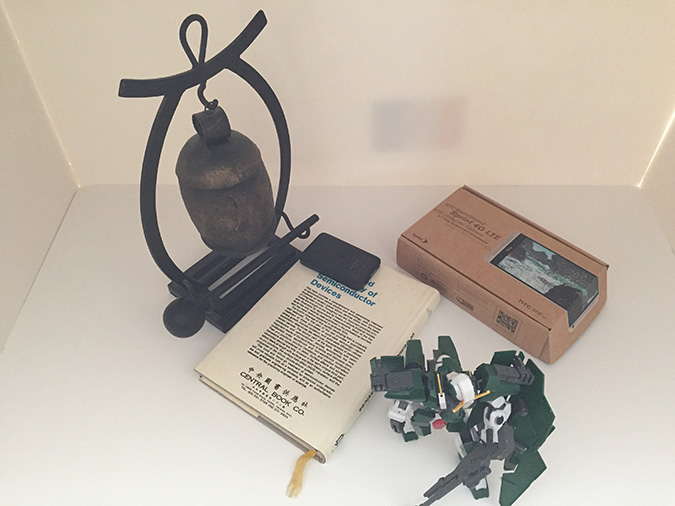






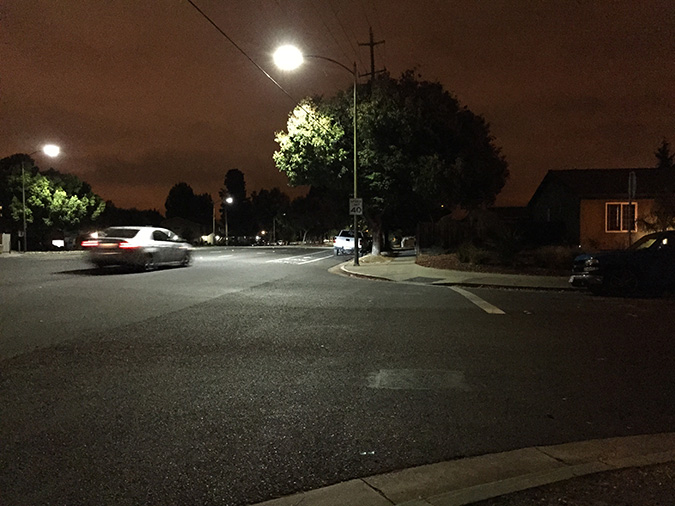









_thumb.jpg)



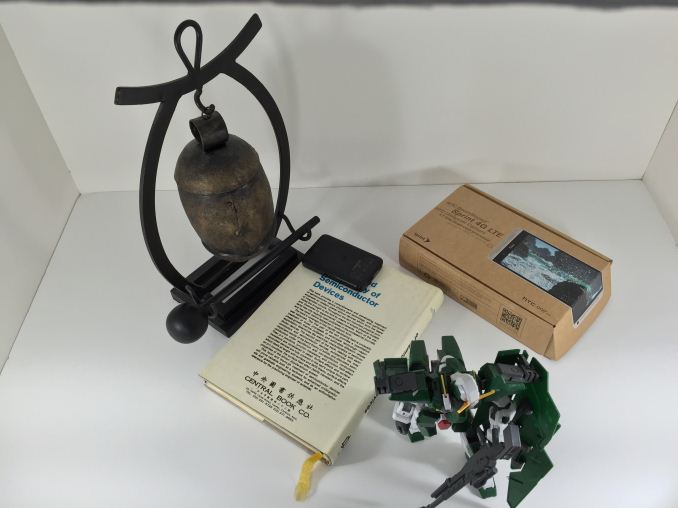








531 Comments
View All Comments
dingodingaling - Thursday, October 2, 2014 - link
1. Is there circumstantial evidence to suggest that AnandTech are Apple Stooges?Yes, absolutely. The founder and owner of the site works for Apple and so does one of their long term “reporters”.
2. Were AnandTech motivated to be Apple Stooges?
Yes, absolutely.
AnandTech are a commercial website, funded by advertising dollars. It is in their interests to drive up traffic and views of their site.
They know that:
a. iPhone users trawl every site that says anything in advance of an iPhone launch to pick up rumours, and after the launch to view “reviews” that help them avoid cognitive dissonance.
b. Apple punish negative reviews by withdrawing access to review devices and invitations to events. http://www.cultofmac.com/255618/how-apples-blackli...
http://www.zdnet.com/blog/apple/apple-prs-dirty-li...
c. Being punished like this will impact them severely from a commercial perspective. They are therefore commercially incentivised to have positive reviews.
3. What means could they use to be Apple Stooges?
Given we know they are motivated and incentivised to give Apple products good reviews, we can analyse how they do it. This can be in 5 basic ways:
a. Use the Apple provided product, not one they brought off the shelf, meaning Apple can tune that one device for tests;
b. Cherry pick tests where the Apple product will do well, and ignore those that they don’t;
c. Carefully select the “comparison” devices, ignoring any that make Apple devices look bad;
d. Make up tests where they think they need to cover up a hole, but ensure that no one else knows how the test works so they can’t repeat it, and
e. Make “mistakes” occasionally and assume no one will notice.
4. Is there evidence to suggest they are using these methods?
a. Use the Apple provided product, not one brought from a store randomly.
Yes we know they do this, and they admit it. Also looking at the Display tests there is evidence to suggest that the Apple provided product was tuned. They themselves had to admit their suspicions.
b. Cherry picking tests.
Yes, they do this.
3DMark Ice Storm
“On the synthetic benchmark 3DMark Ice Storm Unlimited, the iPhone 6 Plus scored 16,965. While that's well above the category average of 13,401, it fell below its Android competition. The S5 blew past with a score of 18,204, as did the HTC One M8 (20,640), the LG G3 (17,548), the OnePlus One (18,399) and the Note 3 (18,321)”
http://www.laptopmag.com/reviews/smartphones/apple...
CNet finds similar results
<image001.jpg>
http://www.cnet.com/products/apple-iphone-6/
An example from Arstechnica
<image002.png>
More results at:
http://results.rightware.com/basemark_x/all-all-ph...
The Stooges select some of their tests (“Basemark X) but not others – why is that??
c. Carefully select the “comparison” devices, ignoring any that make Apple devices look bad;
Yes, they do this.
For the display, the comparisons for max brightness is missing phones for example the Note III which Tom’s hardware measure at 555 Nits. Why the missing phones?? Surely the Stooges have tested these.
One of the missing phones is the Note IV which displaymate tested and rated as the best Smartphone display – and their testing includes both iBends.
“The Best Performing Smartphone or Phablet Display that we have ever tested.”
http://www.displaymate.com/Galaxy_Note4_ShootOut_1...
http://www.displaymate.com/Galaxy_Note4_ShootOut_1...
Suspicious that its missing!
For contrast where are phones like the Galaxy S5? This comparison shows that the S5 has amazing contrast.http://www.phonearena.com/reviews/Apple-iPhone-6-v...
d. Make up tests where they think they need to cover up a hole, but ensure that no one else knows how the test works so they can’t repeat it
Yes, they do this.
For battery Life their test is simply wacko – the only site that has the iBends winning battery life tests and probably due to the rigged nature of the “web browsing” test.
http://gfxbench.com/result.jsp?benchmark=gfx30&...
Tom’s hardware has also has completely different results to the Stooges for battery life and web-browsing http://www.tomsguide.com/us/iphone-6-battery-life,...
Phonearena also have ‘web browsing’ tests that show the iBends aren’t great
http://www.phonearena.com/news/All-bow-to-the-new-...
Arstechnica also found the Ibend battery life to be average.
http://arstechnica.com/apple/2014/09/iphone-6-and-...
e. Make “mistakes” occasionally and assume no one will notice.
Yes, they do this.
Sunspider
The iBend6+ has better measurements than on Tom’s Hardware.
Geekbench 3
The iBend6+ has worse scores on Tom’s hardware than the Galaxy S5 and Note III.
GFXBench 3.0 Manhatten Offscreen
Stooges are rating the IBend6 and iBend6+ higher than GFXBench themselves have tested it at.
http://gfxbench.com/result.jsp
http://laptopmag.com/reviews/smartphones/apple-iph...
The measurement for the iBend6+ is different on Tom’s hardware (its better!), but also different for all the other phones.
More “mistakes” for the colour temperature and gray scale accuracy are completely different in that test as well.
.http://www.phonearena.com/reviews/Apple-iPhone-6-v...
vFunct - Thursday, October 2, 2014 - link
Give it up.Your Android phones area garbage. They're fake iPhones. Apple invented the modern smartphone, and all the innovations like Retina displays. Android keeps trying to copy Apple, but they're never as good or as fast.
Why get a fake iPhone when you can get a real iPhone instead?
Fake iPhones are terrible. Get a real iPhone instead.
KuyaMarkEduard - Sunday, October 5, 2014 - link
Hello Dingodingaling. Are you certain that this practice of Apple is still existing even today, as we speak?""Apple PR's dirty little secret:
Summary: Apple PR maintains a blacklist of journalists that it refuses to talk to. This includes any media outlet that posts anything even remotely negative or heaven help you, a rumor.
Apple's public relations department is notoriously tight-lipped and only responds to a limited subset of the mainstream media, and usually only the outlets that write positive things about its products.
If you dare to write an unflattering piece about Apple or -- heaven forbid -- post a rumor you're almost guaranteed to lose your access to Apple. I know this firsthand because I'm the poster child of Apple's PR blacklist. (I was part of a precedent-setting legal case with Apple in 2005, which I won on appeal in 2007 -- thanks to the Electronic Frontier Foundation.)
Say what you will about my work, but I call 'em like I see 'em.
I write good things about Apple, I write bad things about Apple and I also publish rumors when I believe that they're credible or plausible. I write about things that I find interesting and about topics that will benefit my readers. Sometimes Apple likes what I write other times it doesn't. Apple and I have classic love/hate relationship.
But one thing's for sure, I'm not an Apple cheerleader. If like reading puff pieces about Apple there are a number of websites and blogs that will gladly oblige. Or heck, just dial up apple.com/pr.
Case in point: On February 7 when Arun Thampi posted on his blog that Path was sneakily uploading iPhone user's address books to its server -- without permission -- I called and emailed Apple. Apple didn't reply. Then and I blogged about it.
On February 8 when Dustin Curtis blogged that Apple makes a standard practice of approving apps that upload the entire contents of your iOS address book to developer’s servers I again called and emailed Apple. Apple didn't reply. Then I blogged about it.
Later. Rinse. Repeat.
Then I got an idea. Since Apple PR never responds to my voicemails or emails, maybe they'd respond to the guys that do have access. So I contacted several prominent Apple pundits (who shall remain nameless) that are known for their access to Apple (some of whom get replies from Apple "every time") and I asked them to enquire about Apple's stance on enforcing its policy on address book uploads.
And you know what? None of them would do it.
(Update: ironically there's a couple of exclusive stories out today about Mac OS 10.8/Mountain Lion which certain members of the Mac Illuminati had access to a week early.)
Why? They'd probably say that Apple wouldn't comment. But someone's got to ask if they expect Apple to reply. I mean come on! Apple's not going to press release its shady developers that steal your contacts.
The fact of the matter is that most journos with access to Apple are afraid of losing it. They're afraid of asking the tough questions. They're afraid of getting blacklisted. Like me.
So then I contacted the Wall Street Journal.
There's a prominent columnist at WSJ that has lots of access to Apple. Arguably the most access to Apple. Apple loves the Journal. Apple sends controlled leaks to the Journal. Apple gives unreleased product to the Journal. Surely, Apple would have to respond to the Journal. Right?
Well guess what? Apple spokesman Tom Neumayr replied to AllThings today about the issue of developers stealing your contacts without permission. (More on that later)
Gee? I wonder why?
I'll tell you: AllThingsD is a wholly owned subsidiary of Dow Jones & Company Inc., which is a member of The Wall Street Journal’s Digital Network (which includes WSJ.com, MarketWatch, Barron's, and SmartMoney).
It's simple really. Apple needs the Journal. The Journal doesn't need Apple. And the Journal's not afraid of getting on Apple's PR blacklist -- because it would never happen.
Other wags with access, but without the clout of the Journal are probably afraid of getting blacklisted if they probe around too much -- or ask the tough questions.
My point is that if Apple PR actually read blogs and responded to queries from bloggers things like Address-gate might not explode into giant issues that end up in the Wall Street Journal. Apple could have nipped it in the bud a week sooner by simply replying to my email or voicemail with something to the effect of "yes, we're aware of the issue and we're looking into it."
Instead, Apple makes a conscious point of ignoring certain journalists hoping that unsavory issues like Address-gate blow over and that no one will notice. Well guess what, I'm persistent. And if Apple doesn't reply, I'll contact the people that I know at the Journal -- or my Congressman.
And before you cry "sour grapes!" consider this. I've been blacklisted by Apple for over 10 years. I never get invited, I never get replies. I'm long over it. This doesn't have anything to do with me. It's about you and your privacy. I called and emailed Apple PR because I care about my (and your) private contacts and I wanted to know why Apple isn't enforcing its own privacy policies.
If you don't care about developers stealing your contacts, that's fine. But I do.""
Because if so, with the iBend issue, how can now then we be assured that each and every-time Apple will say a thing about the issue, will always be true, and not fabricated?
This is indeed, an eye-opener to all the Serious tech-readers out-there…, …Of-course, this does-not include the Fanboys.
EricGee - Friday, October 3, 2014 - link
If both new iPhone editions are virtually the same phone, why doesn't the 6 also have landscape view. Both these devices should have an iPad GUI. Landscape view is the most ergonomic position. Having to switch grips from portrait to landscape increases the chance for accidental drops. Landscape also decreases the likelihood for cumulative trauma which include carpal tunnel and digititis. In short, it's just easier to navigate your phone seamlessly by keeping it in your preferred orientation. Lastly, it's sad that I'm waiting for a jailbreak. My plan is not to jailbreak. But if Apple developers can't be aware to what the mass looks for in functionality, jailbreaking may be the only answer. If you would reference Infinidock, this app allows for multiple icons to be docked. Not just four icons. Making these small additions to the user interface would vastly improve the users experience. If developers aren't willing to make such adjustments, then I suggest allowing open code for Cydia jailbreak developers that will allow for users to freely mod our devices.Believe it or not, the ability to freely mod our phones to the users preference is what separates the iPhone and Android users. Hence the jailbreak... Don't patronize your loyal consumers by making such availability this coming S model.
James Wimberley - Friday, October 3, 2014 - link
Anand team: Please consider adding ruggedness tests for mobile devices. Desktops spend their lives in sheltered environments, with a few heatwaves and power cuts and surges. Laptops are occasionally dropped. But tablets and smartphones are constantly being dropped, put in linty pockets, exposed to rain and coffee, bent, scratched, and connected to low-quality chargers. If you a ea SEAL, you need a different order of ruggedness, like the Toughbook. But normal consumer use is still quite deamnding.e34v8 - Friday, October 3, 2014 - link
I have three main complains here.The is the screen resolution. We all know 326 ppi is far, far from enough. I have always been able to see aliasing on iPhone screens (never on my Nexus 5) and aside form that, the image is just not that clear and sharp as on a good 1080p screen. Maybe the 6+ will offer great viewing experience.
The second complain is size. Yes, I think that Apple is making the right move with bigger screen size. Better late than never. The 4.7" are not the ideal size for me, but this is a major improvement. But wtf were Apple thinking, when they made a 4.7" phone, with the dimensions of a 5 or a 5.2"phone? Why? Apple customers value compactness. Just compare it with an old 4.7" phone like the Optimus G - 131.9mm vs 138.1mm .
And last, but not least - 1gb of ram. Are Apple so greedy? This is typical planned obsolescence. I still can't believe it. 64 bit SoC and a gig of ram...
The lack of OIS or wireless charging is also not good.
This phone should cost a lot less.
blackcrayon - Friday, October 3, 2014 - link
"We all know 326 ppi is far, far from enough" - Stopped reading there. It's enough for the vast majority of people, and is certainly a better idea than making a 500 ppi phone that lags.e34v8 - Saturday, October 4, 2014 - link
Well, that's your problem. You should read someone's comment, before you reply.I agree with you. I also hate phones that lag, stutter or miss frames in the UI. That is the reason I do not like Samsung and their Touch Wiz. But that's not the case with my Nexus 5. It's totally stock, but believe me, it's blazing fast and smooth. And it still manages to have a gorgeous 455 ppi screen.
Anyway, there is no such thing as a perfect phone, but Apple could have offered much more, having in mind that it's a flagship expensive device.
michael2k - Monday, October 6, 2014 - link
1) Your eyesight is superior, most aren't nearly as good as yours.2) The Optimus G is 8.45mm thick vs the 6.9mm of the iPhone 6
3) You talk about typical planned obsolescence, yet in the same breath rave about the Nexus 5. The Galaxy Nexus from 2011 won't see either the 2013 KitKat nor the 2014 Android L, whilst the 2011 iPhone 4S saw both the 2013 iOS 7 and the 2014 iOS 8. I would expect a 2014 iPhone 6 to see at least iOS 11, and still be usable! What do you think your 2013 Nexus 5 will see?
4) OIS isn't that important, especially when it already has one of the best cameras in the industry
5) This phone already sold out. Costing less is probably the last thing it needs. Ordered on Sept 20th and expect to see my phone in October 20th.
e34v8 - Thursday, October 9, 2014 - link
The fact that my eyesight is or isn't superior does not change the facts. Ignoring or denying something, without any arguments is not productive. You say that OIS is not important and that's it. Why? I can tell you, I'm never going to buy a phone without OIS again. It's much easier for me to catch perfectly focused shots and shoot steady videos.Anyway, everyone has their own view on things. I think Apple are capable of making a better phone - with thin bezels, full HD screen, more than 1 gig of ram, bigger battery... but they chose not to. I'm not some fanboy that will blindly ignore faults. The iPhone 4 was my last iPhone. I'll continue to wait for something from Apple that's worth the money.